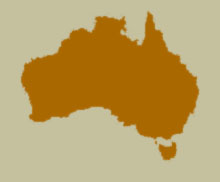Synonyms
Scymnus stragulatus Erichson, 1842: 240.
Bucolinus longicornis Blackburn, 1892: 252.
Rhizobius blackburni Lea, 1908: 205.
Bucolinus stragulatus: Lea 1925: 431.
Bucolus stragulatus: Slipinski 2007: 107.
Diagnosis
The elongate, somewhat flattened body in combination with the poorly developed epipleural foveae and protibiae scarcely angulated externally distinguish this species from the other Bucolus.
Description
Length 2.3-3.4 mm. Colour light to dark brown with lateral parts of pronotum and elytra usually lighter, yellowish-brown; anterior part of head, mouthparts, antennae, legs, prosternum and abdomen yellow or yellowish-brown. Dorsum weakly convex, covered with dense, whitish pubescence forming distinct whorled pattern on elytra. Punctures on head distinctly finer than eye facets, separated by 1.5-2.5 diameters; intervals between punctures shiny without microsculpture. Anterior clypeal margin shallowly and broadly arcuate medially. Apical maxillary palpomere, short and almost parallel sided. Eyes weakly emarginate; at frons separated by about 2.2-2.5 times eye width. Pronotal base not margined; prosternum moderately short in front of procoxae with weak projection that about 0.5 times as broad as prosternum. Prosternal process about 0.5 times as wide as transverse coxal diameter. Hypomeron without distinct foveae. Scutellum triangular, setose. Elytral surface densely irregularly punctate; all punctures setigerous as large as the pronotal ones, 2.0-2.5 diameters apart; interspaces shiny and without noticeable microsculpture. Epipleuron narrowing posteriorly from the level of abdomen and completely absent apically. Foveae distinct: mesofemoral fovea not indicated on metepisternum, weak but clearly delimited posteriorly on epipleuron, the metafemoral fovea very weakly defined and almost not noticeable on epipleuron. Meso-metaventral junction about as wide as mesocoxa; mesoventrite arcuate and weakly bordered anteriorly. All legs narrow and rather long; with tibiae only weakly angulate externally; claws in both sexes appendiculate with basal tooth prominent and short, in male almost as long as claw. Abdominal postcoxal line recurved and complete; ventrite V arcuate with very fine marginal line along outer edge.
Male
UNDER CONSTRUCTION
Female
UNDER CONSTRUCTION
Variation
UNDER CONSTRUCTION
 Distribution and Biology
Distribution and Biology
Apparently widely distributed from Tasmania to southern New South Wales and ACT but not yet recorded from many transitional localities.
Species References
Blackburn, T. 1892. Further notes on Australian Coleoptera,with descriptions of new genera and species. XII. Transactions of the Royal Society of South Australia, 15: 207-261.
Erichson, W. F. 1842. Beitrag zur Insecten-Fauna vonVandiemensland, mit besonderer Berücksichtung der geographischen Verbreitung der Insecten. Archiv für Naturgeschichte, 8: 83-287, pls IV, V.
Lea, A. M. 1908. The Coleoptera of King Island, Bass Strait. Proceedings of the Royal Society of Victoria, 20:143-207.
Lea, A. M. 1925. Descriptions of new species of Australian Coleoptera. Part XVIII. Proceedings of the Linnaean Society of New South Wales, 1(4): 414-431.
Slipinski, A. 2007. Australian Ladybird Beetles (Coleoptera: Coccinellidae) their biology and classification. ABRS, Canberra. 286 pp.
Slipinski, A and Dolambi, F. 2007. Revision of the Australian Coccinellidae (Coleoptera). Part 7. Genus Bucolus Mulsant. Annales Zoologici (Warszawa), 57: 763-781.
[ Top ]
